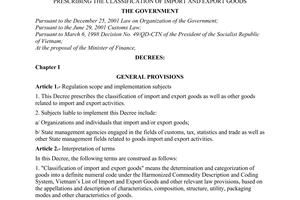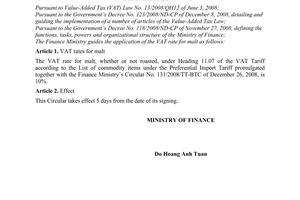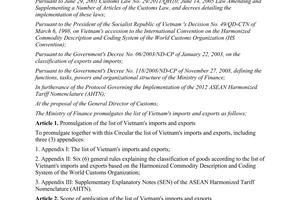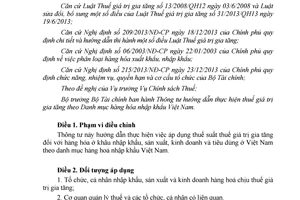Nội dung toàn văn Circular No. 83/2014/TT-BTC guiding the application of value-added tax according to Vietnam’s list of imports
|
THE MINISTRY OF FINANCE |
THE SOCIALIST REPUBLIC
OF VIETNAM |
|
No. 83/2014/TT-BTC |
Hanoi, June 26, 2014 |
CIRCULAR
GUIDING THE APPLICATION OF VALUE-ADDED TAX ACCORDING TO VIETNAM’S LIST OF IMPORTS
Pursuant to June 3, 2008 Law No. 13/2008/QH12 on Value-Added Tax and June 19, 2013 Law No. 31/2013/QH13 Amending and Supplementing a Number of Articles of the Law on Value-Added Tax;
Pursuant to the Government’s Decree No. 209/2013/ND-CP of December 18, 2013, detailing and guiding a number of articles of the Law on Value-Added Tax;
Pursuant to the Government’s Decree No. 06/2003/ND-CP of January 22, 2003, prescribing the classification of imports and exports;
Pursuant to the Government’s Decree No. 215/2013/ND-CP of December 23, 2013, defining the functions, tasks, powers and organizational structure of the Ministry of Finance;
At the proposal of the director of the Tax Policy Department;
The Minister of Finance promulgates the Circular guiding the application of value-added tax according to Vietnam’s list of imports.
Article 1. Scope of regulation
This Circular guides the application of value-added tax (VAT) rates to goods at the stages of importation, production, trading and consumption in Vietnam according to Vietnam’s list of imports.
Article 2. Subjects of application
1. Organizations and individuals importing, producing or trading in VAT-liable goods.
2. Tax administration agencies and related organizations and individuals.
Article 3. VAT tariff
The VAT tariff promulgated together with this Circular comprises:
1. The VAT tariff detailed according to 8-digit headings and goods descriptions according to Vietnam’s list of imports promulgated together with the Ministry of Finance’s Circular No. 156/2011/TT-BTC of November 14, 2011, and added with the item “Particular” with descriptions of specifications according to names of goods liable or not liable to VAT specified in the Value-Added Tax Law and the Law Amending and Supplementing a Number of Articles of the Value-Added Tax Law (below collectively referred to as the Value-Added Tax Law) and guiding legal documents.
2. VAT rates
a/ Mark (*) in the tax rate column in the VAT tariff denotes commodity items not liable to VAT.
For example: The lines for pure-bred breeding horses (sub-heading 0101.21.00) and carriages for disabled persons (sub-headings 8713.10.00 and 8713.90.00) have mark (*) in the tax rate column. This means that commodity items under these 3 sub-headings are not liable to VAT.
b/ Mark (5) in the tax rate column in the VAT tariff denotes commodity items subject to the VAT rate of 5% at all stages of importation, production, processing and trading (including cases in which enterprises or cooperatives that pay VAT by the credit method sell preliminarily processed rubber latex, preliminarily processed pine resin or preliminarily processed cotton to other enterprises or cooperatives at the stage of trading).
For example: The line for preliminarily processed natural rubber latex (heading 40.01) has mark (5) in the tax rate column. This means that such goods item is subject to the VAT rate of 5% at all stages of importation, production and trading. Even in case an enterprise or a cooperative that pays VAT by the credit method sells preliminarily processed natural rubber latex to another enterprise or cooperative at the stage of trading, such goods item is still subject to the VAT rate of 5%.
c/ Mark (*, 5) in the tax rate column in the VAT tariff denotes commodity items not liable to VAT at the stages of self-production, fishing for sale and importation, but subject to the VAT rate of 5% at the stage of trading, except the cases specified at Point b, Clause 3, Article 4 of this Circular.
d/ Mark (10) in the tax rate column in the VAT tariff denotes commodity items subject to the VAT rate of 10% at all stages of importation, production, processing and trading.
For example: The line for bathtub (sub-heading 3922.10.10) has mark (10) in the tax rate column. This means that such goods item, subject to the VAT rate of 10% at the stage of importation, is also subject to the VAT rate of 10% at the stages of production, processing and trading.
e/ Mark (*, 10) in the tax rate column in the VAT tariff denotes the commodity item of imported gold in the form of bar or ingot not yet fashioned into fine-art articles, jewelry or other products (heading 71.08), which is not liable to VAT at the stage of importation but liable to VAT at the stages of production, processing and trading with the tax rate of 10%.
Article 4. General guidance on the application of VAT rates according to the VAT tariff
1. For goods which are not liable to VAT or to be subject to the VAT rate of 5% or 10% as specified in the Value-Added Tax Law and guiding documents, the provisions of such documents shall apply; particularly, cultivation, husbandry, aquatic and marine products; medical equipment or instruments must comply with the provisions of Clauses 3,4 and 5, Article 4 of this Circular.
For example: According to the VAT tariff, heading 87.05 “special-purpose motor vehicles, other than those principally designed for the transport of persons or goods (for example, breakdown lorries, crane lorries, fire engines, concrete-mixer lorries, road-sweeper lorries, spraying lorries, mobile workshops, mobile radiological units)” is specified to be subject to the VAT rate of 10%, so all imports under heading 87.05 are liable to the VAT rate of 10%. However, in case a vehicle under heading 87.05 is determined as military equipment exclusively used for national defense and security purposes as prescribed Clause 18, Article 5 of the Value-Added Tax Law, it will not be liable to VAT.
2. The VAT rate specified for each 8-digit sub-heading shall apply to all goods items under such sub-heading, except those under the 4-digit heading concerned with their names specified at the item “Particular” which are subject to the VAT rate specified at the item “Particular”.
For example: “Rulers” under sub-heading 9017.20.10 are subject to the VAT rate of 10%, but “rulers used for teaching and learning” under heading 90.17 are subject to the VAT rate of 5% as specified at item “Particular” of heading 90.17.
3. The VAT rates on cultivation products (plant products and products from plants); husbandry products (livestock products and products from livestock, including also offal and other byproducts obtained from slaughtered animals); forest, aquatic and marine products (from natural or planted forests) specified in Chapters 1 thru 12 and Chapter 18 of the VAT tariff promulgated together with this Circular are applied as follows:
a/ The tax rate (*, 5) specified in the VAT tariff promulgated together with this Circular shall apply to products not yet processed into other products or just preliminarily processed by ordinary methods, including those cleaned, sun-dried, heat-dried, pitted, stemmed, cut or ground (except ground products defined in Chapters 9, 10, 11 and 12 of the VAT tariff promulgated together with this Circular), chopped, husked, broken, polished, glazed, preserved in airtight boxes, or ordinarily preserved such as cold-preserved (frozen or chilled), preserved with sulfur dioxide, impregnated with preservative chemicals, preserved with salt (salted, soaked in bittern), soaked in sulfur solution or other preservative solutions or otherwise ordinarily preserved, except those specified at Point b of this Clause.
b/ The VAT rate applicable to unprocessed or preliminarily processed cultivation, husbandry or aquatic products, and fresh or raw foods at the stage of trading is as follows:
b.1/ Enterprises and cooperatives that pay VAT by the credit method and sell unprocessed or preliminarily processed cultivation, husbandry or aquatic products, and fresh or raw foods to other enterprises and cooperatives at the stage of trading are not required to declare, calculate and pay VAT. In value-added invoices, they shall write selling prices being VAT-exclusive prices and cross out the VAT rate and VAT amount lines.
For example: Material shrimps (cleaned, whole or headless, peeled, back-cut, deveined, straight-pressed, put in trays, vacuumed and chilled); fresh cuttlefishes (cleaned, classified, cut in pieces, put in trays and frozen); fish fillets, frozen shrimps and fishes; cashew nuts (sun-dried, screened, steamed, cut and split, heat-dried, husked and fumigated); paddy already milled and husked into rice, polished rice; discarded products and byproducts of cultivation, husbandry or aquatic products such as broken rice, rice husk and bran, shrimp heads and shells, fish heads and bones, offal and discarded products obtained from slaughtered animals and fresh grease which have not yet been processed into other products or have just been preliminarily processed by ordinary methods are not subject to declaration, calculation and payment of VAT at the stage of trading.
b.2/ Business households and individuals, enterprises, cooperatives and other economic organizations that pay VAT by the direct method and sell unprocessed or preliminarily processed cultivation, husbandry and aquatic products, and fresh and raw foods shall declare, calculate and pay VAT at the stage of trading at the rate of 1 % of turnover.
For example: Food company B pays VAT by the credit method. If the company imports or purchases rice directly from rice farmers, such rice is not liable to VAT at the stage of importation or purchase.
In case company B sells such rice to import-export company c, it shall not be required to declare, calculate and pay VAT on the rice quantity sold to company c.
In case company B sells such rice to limited liability company D (which produces rice vermicelli and noodle), it shall not be required to declare, calculate and pay VAT on the rice quantity sold to company D.
In value-added invoices made and handed to companies c and D, company B shall clearly write the selling prices which are VAT-exclusive prices and cross out the VAT rate and VAT amount lines.
In case company B sells such rice directly to consumers, it shall declare and pay VAT at the rate of 5%.
c/ Products which have not yet been preliminarily processed by ordinary methods as prescribed at Point a of this Clause shall be regarded as processed products and subject to the VAT rate of 10% at all stages of importation, production, processing and trading.
4. Cultivation, husbandry and aquatic products which have not yet been processed into other products or have just been preliminarily processed by ordinary methods sold by producing or fishing individuals and organizations themselves or imported for use as feed for cattle, poultry and other domestic animals (collectively referred to as animal feed) are not liable to VAT under Clause 1, Article 5 of the Value-Added Tax Law.
For example: Unprocessed rice, maize, potato, cassava and wheat (including also those used as animal feed) which are sold by producers or imported shall not be liable to VAT (the VAT rate of 5% shall not apply in all stages as for animal feed of other kinds).
5. Medical equipment and instruments, including special-use medical machinery and instruments such as scanners, screeners and radiography machines for medical examination and treatment; devices and instruments used exclusively in surgery and wound treatment; ambulances; blood pressure and cardiovascular meters, blood transfusion tools; syringes and needles; contraceptive devices and other special-use medical equipment, must comply with the VAT tariff promulgated together with this Circular.
Article 5. Organization of implementation
1. This Circular takes effect on August 10, 2014.
2. This Circular replaces the Ministry of Finance’s Circular No. 131/2008/TT-BTC of December 26, 2008, guiding the application of VAT rates according to the Preferential Import Tariff; Circular No. 74/2009/TT-BTC of April 13,2009, amending Circular No. 131/2008/TT-BTC; and Circular No. 84/2009/TT-BTC of April 28,2009, amending Circular No. 131/2008/TT-BTC;
3. In the course of implementation of this Circular, if there is any problem or inconsistency with regard to the application of VAT to a commodity item when it is imported and when it is domestically produced, traded or consumed, the declaration and calculation of VAT at the stage of importation must comply with this Circular, and at the same time, organizations, individuals, tax offices and customs offices shall promptly report the case to the Ministry of Finance for guidance and uniform implementation.-
|
|
FOR THE MINISTER OF FINANCE |







